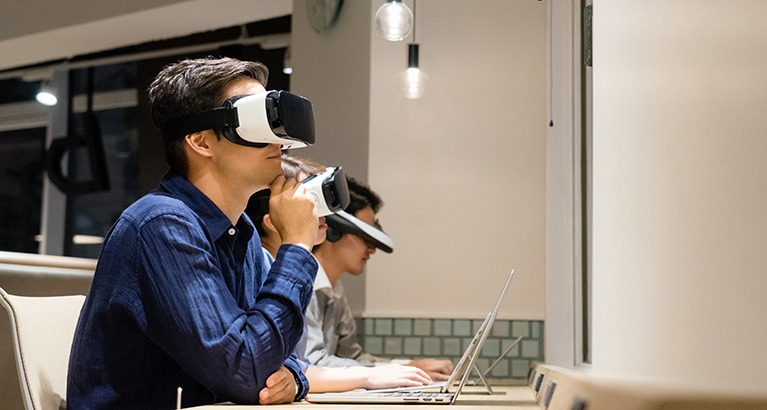Successful companies regularly launch new products, as existing markets become saturated and firms seek new avenues for growth. But how do companies introduce their new products in terms of promotion, pricing and other key marketing metrics?

Vincent Mak, Professor of Marketing and Decision Sciences at Cambridge Judge Business School, has given this topic plenty of thought in line with various theories on product launches and promotion – and the launch earlier this year in the US of Apple’s new VisionPro mixed reality headset provides an opportunity to explore this issue: while Apple frequently launches new versions of its popular iPhone, iPad and other products, the VisionPro marks Apple’s first new product category since the Apple Watch debuted in 2015.
A very different approach to Apple’s has been pursued by Bobak Tavangar, an MPhil in Management graduate (MPhil 2012) of Cambridge Judge and the co-founder and CEO of Brilliant Labs, a Singapore-based company that is making AI-powered glasses, called Frame, that are powered by artificial intelligence (AI).
Both these approaches were examined in recent editions of the Balance Sheet podcast hosted by Conrad Chua, Executive Director of the Cambridge MBA programme at Cambridge Judge Business School – in this article we cover excerpts from these podcasts with Vincent Mak and Bobak Tavangar.
Pricing wearable tech
Before launching a new product, marketing professionals have for a long time focused on the 4 Ps:
- product
- price
- place
- promotion
These are also known in marketing as the ‘marketing mix’.
In the case of the VisionPro, Apple has pitched the VisionPro as mixed reality or ‘spatial computing’ rather than a virtual reality device that amounts to a 3D camera. Its promotional adverts say the device is “familiar yet groundbreaking”. The price is hefty, with a cost of $3.499 (it is not yet available in the UK) clearly marking it as a high-end product, and for Apple the physical place of sale is its sleek Apple-branded stores.
Brilliant Lab’s Frame, in contrast, is priced at $349, and the company says that it is unusual in that it’s a “hardware start-up” whose business model is based around its open-source philosophy aimed at attracting developers and others to the concept.
Vincent Mak on marketing new products

Some edited excerpts from the podcast with Vincent Mak of Cambridge Judge:
Is it a good idea for luxury brands to showcase the price when marketing a new product?
The price actually makes you think about money. So, if you want to market your product as a high-class brand, as a brand that will convey high value and quality, you’d want people to think of the product as a more high-level product, and to think about values, life transformation, and being cool. In the case of Apple, they really have to give out the price point: it seems they are not making a huge fuss about it but are more concentrated on the cutting-edge gadget with great specifications.
Why do we have prices like $3.499, instead of a round number like $3.500?
The non-round number price is based on consumer behaviour research, because it might be useful for people on the margin who really have the final doubts about whether to buy it or not. Usually, the number nine effect is more impactful on non-premium products, where you want to mass sell. But maybe Apple already has its eyes on the mass-selling aspect, that VisionPro might not be that premium at some point in time.
What is the interplay between product strategy and product marketing?
In terms of new product pricing, there are 2 strategies.
- One is the penetration pricing strategy in which you really price it cheap in order to get as large an installed customer base as possible to exploit the network effect.
- The other one is probably what Apple is trying to do, which is skim pricing that aims to attract the most staunch believers. It is these believers who really want to use cutting-edge gadgets and then spread the word if they think it’s good. Apple has a fan community who would really go to the ends of the world in order to spread the word. The company would then want to capture the buzz, to create a sense of being part of the community – and what they do next is probably to reduce the price and release new versions that are more common and consumer friendly.
How can some products break the rules on promotion where a great product builds up with little or no advertising?
A zero-advertising budget could be one of the options. I think the best way to promote your product is not to advertise, but to do it by word of mouth. That means you should not promote the product yourself but get other people to do this. There is this slightly mythic rule about the one central market research question you should ask in a survey if people don’t have more time for you, and that one question is about how likely is it that the consumer will recommend your product to other people. Doing things that create this may cost you very little, if you do them well. For example, you could run events where you just meet with some of your fans very casually, or just try to work on your social media where people talk about you.
Is Apple’s VisionPro going to be a success like iPhone, or do you think it will maybe flop like Google Glass?
If you look at a product like the iPod, it didn’t necessarily fizzle out but sort of morphed into something else, the iPhone. So, this could be another product that will be absorbed into something else after a few years.
Bobak Tavangar on Brilliant Labs’ AI glasses
Some excerpts from the podcast with Bobak Tavangar of Brilliant Labs.
What is the core essence behind Frame?
Frame is as light and as thin as a pair of glasses that people wear every single day. There is a little charging dock that powers the battery, and there is little bit of text in the display – a see-through holographic display. Frame interfaces with a cloud-based AI agent: ours is called Noa, and its job is to understand what a user’s question might be and then go to any range of large language models for the answer. The idea is that it leaves you hands free.
Your idea for Frame is quite different from the kind of vision that you see on Meta Oculus or Apple VisionPro. Why did you decide to go down this path versus what those guys are doing?
Take the Apple VisionPro, it’s a VR device. And I think that’s a market in and of itself. It has its own set of use cases, its own set of technical challenges and dynamics. And Apple’s clearly chosen that as the beachhead for them. So, the key difference is that we are very open and ecosystem focused; Meta has that all closed off, so what you do with it is really only limited to what Meta themselves have launched or allow you to do with it.
You emphasise that you have kept Frame open source. Please explain the reasoning behind this?
We’ve kept it totally open source, because we want to empower a world of developers that are really sinking their teeth into this new creative medium of generative AI to begin tinkering and exploring what’s possible. Since we announced about 2 months ago, we’ve had developers coming out of the woodwork – anyone from large manufacturing, to agriculture, to industrial companies that are looking to train a model. And then, of course, there’s a lot of folks on the startup side of things, AI companies, building a proprietary model that they want embodied on the end user: maybe they’re serving doctors and EMTs (emergency medical technicians) in a medical setting, or maybe they’re serving teachers in the education setting, or lawyers who are poring through reams of documentation.
Are there other advantages to your open source approach?
We think about this 3 ways.
- The first is that to have technology be inspectable, it should be modifiable.
- The second is that we just think that a lot of people have some really cool ideas around generative AI.
- The third reason, and this is more long-term strategic thinking, is that our bet is that the genius and the value is in the data – it not in the model, and it’s not in the hardware design.
You mentioned that will.i.am, the Black Eyed Peas musician and design/fashion icon, has tried Frame. I have to ask, what does he think?
He looks great in them. He looks very professorial and he absolutely loved it. I’m wearing his glasses. And I don’t think they look half as good as on me as Frame does on him, but that’s okay. I don’t think that was the point.
Related content
The podcast episodes mentioned in this article are both part of the Balance Sheet podcast:





